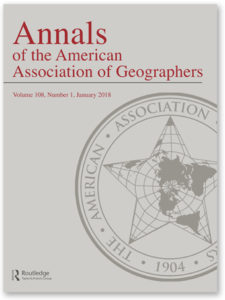2017 Annual Reports of the AAG Regional Divisions
2017 Annual Reports of the AAG Regional Divisions
Reports from Regional Councilors
Regional Councilor Chair Shawn Hutchinson shared the highlights to the regional reports, and he shared the full report electronically with members of the Council. The full reports will be published on the AAG website.
East Lakes
Patrick Lawrence reported that there is uncertain state support and concern for emerging potential policies impacting higher education in Ohio and Michigan. He said there is a need for more engagement with K-12 geography education including the Ohio Geographic Alliance, Advanced Placement (AP), and other high school college credit programs.
Great Plains-Rocky Mountains
Hutchinson reported that the GPRM meeting will be hosted by the University of North Dakota on October 13–14, 2017. Hutchinson noted the expansion of geotechnology (including GIS and UAV) and online programs buoying enrollment for many regional programs, many of whom continue to operate under increasingly challenging budgetary conditions.
Middle Atlantic
The division had no report, but Hutchinson reported that Rebecca Kelly of Johns Hopkins was recently elected regional councilor.
Middle States
Robert Mason highlighted a response to a distressed department: Long Island University, Post Campus, which suspended admissions for the Geography major. Mason said division members are asking how, if at all, do departments respond to the administration travel bans at local and regional levels.
New England/St. Lawrence Valley
John Hayes reported that NESTVAL had a successful meeting on the campus of Bishop’s University during October 14-15, 2016, in Sherbrooke, QC, Canada. The conference theme was “Multi-Scale Climate and Environmental Change.” The upcoming meeting will be hosted by Central Connecticut State University during October 20–21, 2017, in New Britain, CT. The conference theme will be “Geography in the Community.” The annual, peer-reviewed journal of NESTVAL, The Northeastern Geographer, will publish the next two volumes as special issues on Climate Change in the Northeast and Food Geographies of the NESTVAL Region.
Pacific Coast
Sriram Khé reported that the upcoming APCG meeting will be in Chico, CA, during October 25–28, 2017. Hosted by the Department of Geography and Planning at California State University, Chico, the conference theme is “Sustainable Communities.” He reported that several new programs have been established within the region including four new undergraduate specializations and three new minors at the University of Nevada Reno and three new programs at the University of Southern California, including an interdisciplinary PhD and MS degrees, and an interdisciplinary undergraduate minor.
Southeastern
Thomas Mote reported that the next SEDAAG meeting will be November 19–21, 2017, in Starkville, MS, with local arrangements handled by Mississippi State University. He reported that departments are being creative and innovative about ways in which they attract students and seek support, with much emphasis placed in online programs, geospatial technologies and environmental-related studies. New undergraduate programs are now being offered, or are being proposed, at the University of Florida, Florida State University, Marshall University, and the University of Georgia. At the graduate level, East Carolina State University now offers a Professional Science Masters in GIS&T, and UNC Charlotte is considering a name change for their Ph.D. degree from “Geography and Urban Regional Analysis” to “Geography.”
Southwest
Darren Purcell reported that the University of North Texas Department of Geography and the Environment was selected as the inaugural winner of the Master’s Program Excellence Award. Additionally, the department will strengthen their international offerings with a China Field School in Summer 2017. He also said the Department of Geography at Oklahoma State University received state approval for a Global Studies BA. A new minor in Global Studies is pending approval. This is the fourth undergraduate program managed by the department, adding to their existing BA and BS in Geography and BS in Geospatial Information Science degree programs.
West Lakes
Julie Cidell reported that the regional meeting was successful despite being in a geographic extreme of the region: Marquette, MI. She reported that departments are trying many different approaches to increase enrollment and/or majors and asked if it would it be useful to do a survey of departments to see what changes have been made in the past 5-10 years and what effect they have had. She said members mentioned that they want the Association to do more in this regard.
Hutchinson reviewed the regional reports in response to the call of the Executive Committee to identify the impact of changes in federal policies. A few regions mentioned the effects of federal policies on their programs, with the federal travel policies raising concerns about international student recruitment. He also mentioned the expressions of appreciation for the Association responses to those policies.
Hutchinson said the common theme among most regions was the effect of state budgets on higher education. Many of the regions’ reports mentioned issues regarding declining undergraduate enrollment, which may be related to online programs, AP credit, and transfer credit from other institutions. Purcell asked whether anyone had provided data about the effect of AP Human Geography, as the effect of the AP exam has been a common concern without supporting data. McAnneny suggested that other AP courses may also play a role. Hutchinson discussed the role of geography as a “discovery major” and the importance of contact in the college level. Cidell said that at the University of Illinois 6% of students took AP Human Geography, and of those students, only 6% enrolled in a geography course at the university. Purcell suggested reaching out to the 200,000 students taking AP Human Geography, as well as the people teaching the course. Bednarz emphasized the importance of creating a pipeline with teachers of AP Human Geography. Alderman talked about reaching out to high school guidance counselors, college and university advisers, and community colleges. Chris Hair mentioned the importance of media and video that explain what students can do with a geography degree. MacDonald said that UCLA uses an open house with community colleges to attract students. Lawrence mentioned the use of the Penn State Geospatial Revolution materials for recruitment plus alumni videos, which have received positive feedback. Richardson commented that he is seeking support from National Geographic to produce promotional videos, but he said it is also worthwhile to determine what is available online that could be used pending permission. He said the media landscape has changed and this may need to be in the form of a social media campaign. Sue Roberts suggested that the Association have a repository of promotional materials that departments produced. Hutchinson mentioned that Kansas State University worked with media professionals in the university to produce brief videos that were targeted to prospective students and their parents.
MacDonald asked that the departmental recruitment effort become an Association priority and suggested that Meridian Place hire someone to help develop media targeted for use by departments seeking to grow enrollment. He said there should be some video presence but the effort should use multiple media platforms. MacDonald said a report to Council regarding progress in this effort should be presented at the Fall 2017 Council meeting. At the annual meeting in New Orleans, he said there should be a session on best practices followed by a document on best practices.
Khé asked about the regional councilor election concerns expressed by Bednarz, particularly in light of the delayed election in one region. Lawrence asked what mechanism is available for expressing concern and offering assistance when regional divisions struggle. The individual regional councilors shared the process for elections in their regions, focusing on nomination processes, eligible voters, timeline, and the form of the election. Richardson shared the rules for electing regional councilors. Bednarz recommended a sub-committee of regional councilors that would examine election processes in each region.
MacDonald stated that Regional Councilors should be elected by AAG members in each regional division, regardless of their regional division membership status.


